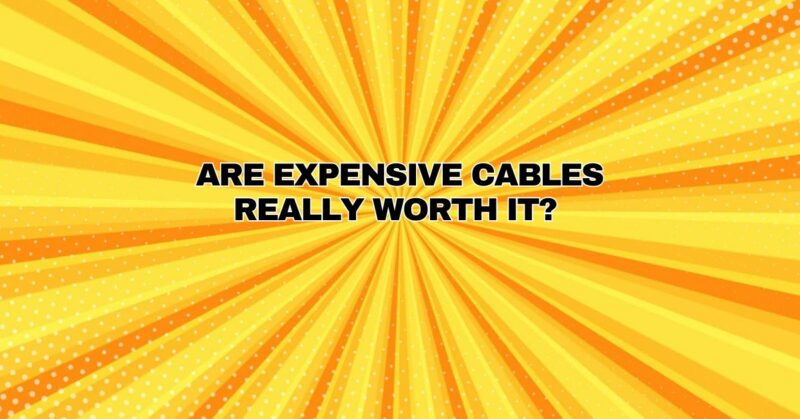In the world of audio and video equipment, debates over the value of expensive cables have raged for years. Some swear by high-end, premium cables, asserting that they deliver superior audio and video quality, while others argue that such claims are nothing more than marketing hype. To navigate this contentious topic, we’ll explore the factors that contribute to cable quality and determine whether expensive cables are genuinely worth the investment.
The Basics of Audio and Video Cables
Before diving into the debate, let’s establish a foundational understanding of audio and video cables:
- Functionality: Cables are responsible for transmitting audio and video signals between various audio-visual components such as TVs, speakers, amplifiers, and source devices (e.g., DVD players, gaming consoles).
- Types of Cables:
- Analog Cables: These transmit signals as electrical voltages. Common examples include RCA and 3.5mm audio cables.
- Digital Cables: These transmit binary data in the form of 0s and 1s. Common examples include HDMI, optical (Toslink), and USB cables.
- Factors Influencing Cable Quality: Several factors can affect cable quality, including cable materials, construction, connectors, and shielding.
The Debate: Are Expensive Cables Worth It?
The controversy surrounding expensive cables centers on whether the benefits they offer justify their higher price tags. To answer this question, let’s consider various aspects of cable quality and the arguments from both sides.
Arguments in Favor of Expensive Cables:
- Materials and Build Quality:
- Premium cables often use high-quality materials like gold-plated connectors, oxygen-free copper conductors, and superior insulation. These materials can enhance signal transmission and durability.
- Reduced Interference:
- Expensive cables may feature advanced shielding and noise-reduction technologies, reducing electromagnetic interference and preserving signal integrity.
- Enhanced Performance:
- Advocates claim that expensive cables can result in clearer audio and video signals, reduced distortion, and improved overall performance, particularly in high-end audio and home theater setups.
- Longevity:
- Higher-quality cables are often built to last, which can save you money in the long run by reducing the need for frequent replacements.
Arguments Against Expensive Cables:
- Diminishing Returns:
- Skeptics argue that the improvements gained from expensive cables may be minimal and not proportional to the price increase. In other words, the law of diminishing returns comes into play.
- Subjective Perception:
- The perceived improvement in audio and video quality is often subjective and can vary from person to person. Placebo effects and confirmation bias may play a role in perceived differences.
- Alternative Solutions:
- Lower-cost cables that meet industry standards can often provide excellent audio and video quality. Critics suggest that investing in better components (e.g., speakers, amplifiers) might yield more noticeable improvements than expensive cables.
- Marketing and Branding:
- Some argue that the high price of premium cables is driven by marketing and branding rather than objective performance gains.
Balancing Quality and Budget
The question of whether expensive cables are worth it ultimately hinges on individual preferences, needs, and budget constraints. Here are some considerations for finding the right balance:
- Purpose:
- Determine the specific purpose of your cable needs. High-quality cables may be more justified in a professional recording studio than in a casual home entertainment setup.
- System Quality:
- Invest in cables that match the quality of your audio-visual components. High-end equipment may benefit more from premium cables.
- Personal Sensitivity:
- Consider your personal sensitivity to audio and video quality. Some individuals may notice subtle differences more than others.
- Budget Constraints:
- Be mindful of your budget. Allocate your resources where they can have the most significant impact on your audio-visual experience, whether that means investing in better speakers, a high-definition TV, or other components.
Conclusion
The debate over the value of expensive cables remains a contentious topic in the world of audio and video equipment. While there are arguments in favor of premium cables, including materials, reduced interference, and enhanced performance, there are also counterarguments emphasizing diminishing returns, subjectivity, and alternative solutions.
Ultimately, the decision to invest in expensive cables should be based on your individual priorities, needs, and budget. It’s essential to strike a balance between achieving the desired audio-visual quality and being mindful of cost-effectiveness. Whether you choose budget-friendly or premium cables, what matters most is that your audio and video equipment provides you with the enjoyment and functionality you desire, making every dollar spent truly worthwhile.


